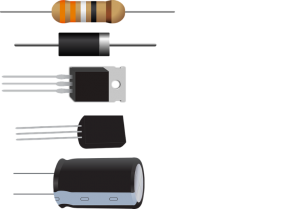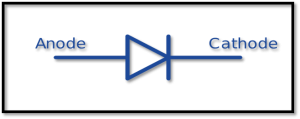C O N T E N T S
- Definition
- Diode symbol
- Important features
- Biasing technique of Diodes
- Important Types
- Applications of Diodes
What are Diodes?
Definition of Diode:
“A diode is a special electronic element with two electrodes termed as the Anode and the Cathode”.

Most of the diodes are made of semiconductors such as silicon, germanium, or selenium.
How does a Diode function?
Working Principle of diode:
The basic characteristics of a diode is to carry electric current in only one direction. If the cathode is negatively charged at a voltage greater than the anode, a certain current called ‘forward break over’ starts flowing through it.
When the cathode is +ve charged in respect of the anode, it will not conduct any current. These can be operated as a rectifiers, switches and limiters.
The forward break over voltage is approximately 0.6 Volt for silicon, 0.3 Volt for germanium and 1 Volt for selenium material respectively.
At the forward break over point, if an analog signal flow through the diode the signal waveform is inaccurate and distorting. All the signals that get generated are harmonic and integral multiples if the input frequency. These generally produce signals at microwave frequency with the correct level and polarity of voltage application.
Symbol of Diode:

Important features of Diodes:
- Diode is a two terminal electronic component
- It has lower resistance in one direction and higher in another direction
- Most of the diodes are made of silicon
- The voltage drop under a forward bias condition is 0.7 volts approximately.
- In the reverse biasing the region of depletion layer, will increase.
Different types of diode:
1. P-N junction diode –
“A diode is a P-N junction with P-type on one side and N-type on the other side”.
2. Light Emitting Diode (LED) –
“LED is a semiconductor light source that emits light when current flows through it”.
3. Photo Diode –
“This is a semiconductor-based P-N junction diode, if exposed to light produce a potential difference”
4. Schottky Diode –
“This is designed by the junction of a semiconductor with a metal. Sometime known as hot carrier diode”.
5. Tunnel Diode –
“ A semiconductor diode that has effectively negative resistance due to the tunnelling”.
6. Varactor diode –
“A diode with changing internal capacitance with the changes of the reverse voltage”.
7. Zener Diode –
“A special type of diode, designed to allow current to carry backwards when a reverse voltage is applied”.
What are the Ideal Diodes?
In an ideal diode, when it is in forward bias the current starts flowing freely from the device. In an ideal one usually without voltage drop when forward biased. All the other voltage sources are dropped across the circuit resistors. When reverse biased, in an ideal diode there is zero current flow and will have infinite resistance.
What are Practical Diodes?
In a practical diode, some of the resistances allow the current to flow if forward bias. Due to the presence of the resistances, some power is dissipated when the current starts flowing through the forward biased. When it’s in reverse biased, due to the high resistance it can conduct.
A diode is normally is P-N junction.
- It is a barrier potential. To overcome this problem by applying an extra voltage to the p-n junction, it can be able to conduct.
- So current will pass through p-n junction when the barrier potential is omitted.
- It is with two metallic conducts is known as p-n junction.
- The process of external voltage applying is channel biasing.
Forward Bias:

Image Credit: S-kei , PnJunction-Diode-ForwardBias, CC BY-SA 2.5
- A battery connected +ve terminal to p-side of p-n junction diode & then connect -ve terminal to the n side.
- If we apply an external voltage which is greater than the potential barrier then it starts conducting the current to pass
- The diode is connected to a DC voltage source (V)
- The voltage across the diode is called forward characteristic of p-n junction diode
- No diode current flows till A is reached because external voltage Vf is being opposed by built in voltage whose value is 0.
- However voltage increases beyond A and the diode current decreases rapidly.
- If the forward current is externally backward it cuts the voltage axis at a point from which Vk can be determined
Reverse Bias:
Image Credit: S-kei, PnJunction-Diode-ReverseBias, CC BY-SA 2.5
- If voltage is applied to p-n junction diodes –ve terminal is connected to the p-type semiconductor. Similarly, +ve terminal is connected to the n-type.
- Holes from p-side are attracted towards the -ve terminal. Whereas the free electrons from n-side are attracted towards +ve terminal.
- The reverse bias increases in steps and diode current is observed.
- When the reverse bias increases VBR the diode reverse current increases very shortly.
Switching property of diodes:
In forward bias when a small voltage is applied the diode conducts which exceeds the cut in voltage known as on-state.
In reverse bias only small voltage current sources with reverse applied voltage that is less than the breakdown value is known as off-state
In switching property of a diode is switched from forward bias on-state to reverse bias off-state or vice versa.
Applications of a diodes
Rectification:
A diode is usually acting as a rectifier, flattening an AC power source into a constant power supply. This can achieve this task by obstructive the flow in one direction and pass through the other direction.
Light emission:
LED provides a much more efficient source of light. The bulbs are cost more than their incandescent counterparts, in part because they require additional control circuitry to work with AC power.
Inductive Load Dissipation:
Diodes are used in this application, when an inductive load is switched off, the energy it has stored must go somewhere. Without the proper circuit protection, the stored energy can lead to voltage spikes that can arc across the switch and potentially overload a transistor this configuration allows the current to dissipate across the inductor and it feeds back into the power supply and protects the circuit.
Sensing and Control:
Semiconductors can easily generate electrical charges based on the optical effects. In general, these devices are packaged in such a way that it blocks out light to avoid unintended electrical activity. Photodiodes are built to optimize this effect. These photodiodes are often used in the infrared spectrum, such as inside consumer remote controls.
For more Electronics related article click here

Hi, I am Soumali Bhattacharya. I have done Master’s in Electronics.
I am currently invested in the field of Electronics and communication.
My articles are focused on the major areas of core electronics in a very simple yet informative approach.
I am a vivid learner and try to keep myself updated with all the latest technologies in the field of Electronics domains.
Let’s connect through LinkedIn –